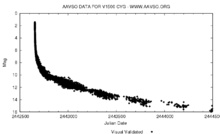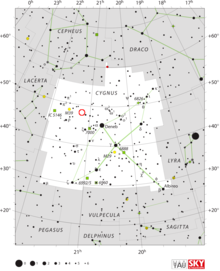 Nova Cygni 1975 (center), photographed at 07:00 UT August 30, 1975. Also shown are 59 Cygni (magnitude 4.8), 60 Cygni (magnitude 5.4) and 63 Cygni (magnitude 4.5) | |
| Observation data Epoch J2000.0 Equinox J2000.0 | |
|---|---|
| Constellation | Cygnus |
| Right ascension | 21 11 36.5810 |
| Declination | +48° 09′ 01.952″ |
| Apparent magnitude (V) | 1.69 to <21 |
| Characteristics | |
| Variable type | Fast nova + asynchronous polar |
| Astrometry | |
| Proper motion (μ) | RA: −6.449(131) mas/yr Dec.: −5.572(112) mas/yr |
| Parallax (π) | 0.6427 ± 0.1087 mas |
| Distance | approx. 5,100 ly (approx. 1,600 pc) |
| Absolute magnitude (MV) | −10.7 (maximum) to +7.8 (minimum) |
| Details | |
| WD | |
| Mass | 1.20 M☉ |
| Radius | 0.009 R☉ |
| Luminosity | 5 L☉ |
| Temperature | 54,000 K |
| donor | |
| Mass | ~0.22 M☉ |
| Radius | 0.42 R☉ |
| Temperature | 3,000 - 5,200 K |
| Other designations | |
| Nova Cyg 1975, AAVSO 2108+47, Gaia DR3 2165295912482637312 | |
| Database references | |
| SIMBAD | data |

V1500 Cygni or Nova Cygni 1975 was a bright nova occurring in 1975 in the constellation Cygnus. It had the second highest intrinsic brightness of any nova of the 20th century, exceeded only by CP Puppis in 1942.
V1500 Cygni was discovered shining at an apparent brightness of magnitude 3.0 by Minoru Honda of Kurashiki, Japan on 29 August 1975. It had brightened to magnitude 1.7 on the next day, and then rapidly faded. It remained visible to the naked eye for about a week, and 680 days after reaching maximum the star had dimmed by 12.5 magnitudes.

It is an AM Herculis type star, consisting of a red dwarf secondary depositing a stream of material onto a highly magnetized white dwarf primary. The distance of the V1500 Cygni was calculated in 1977 by the McDonald Observatory at 1.95 kiloparsecs (6,360 light years). More recently the Gaia space observatory determined a distance of approximately 5,100 light years. Additionally, V1500 Cyg was the first asynchronous polar to be discovered. This distinction refers to the fact that the white dwarf's spin period is slightly different from the binary orbital period. However, by 2016, x-ray observations strongly suggested that the white dwarf rotation had returned to normal synchronization with the orbit.
V1500 Cygni has a remnant typical of very fast novae, consisting of some clumps and some spherically symmetric diffuse material.
See also
References
- ^ Vallenari, A.; et al. (Gaia collaboration) (2023). "Gaia Data Release 3. Summary of the content and survey properties". Astronomy and Astrophysics. 674: A1. arXiv:2208.00211. Bibcode:2023A&A...674A...1G. doi:10.1051/0004-6361/202243940. S2CID 244398875. Gaia DR3 record for this source at VizieR.
- ^ Samus, N. N.; Durlevich, O. V.; et al. (2009). "VizieR Online Data Catalog: General Catalogue of Variable Stars (Samus+ 2007-2013)". VizieR On-line Data Catalog: B/GCVS. Originally Published in: 2009yCat....102025S. 1: B/gcvs. Bibcode:2009yCat....102025S.
- Pavlenko, E. P.; Mason, P. A.; Sosnovskij, A. A.; Shugarov, S. Yu; Babina, Ju V.; Antonyuk, K. A.; Andreev, M. V.; Pit, N. V.; Antonyuk, O. I.; Baklanov, A. V. (2018). "Asynchronous polar V1500 Cyg: Orbital, spin, and beat periods". Monthly Notices of the Royal Astronomical Society. 479 (1): 341. arXiv:1806.03610. Bibcode:2018MNRAS.479..341P. doi:10.1093/mnras/sty1494. S2CID 119083203.
- ^ Harrison, Thomas E.; Campbell, Ryan K. (2016). "The apparent synchronization of V1500 Cygni". Monthly Notices of the Royal Astronomical Society. 459 (4): 4161. Bibcode:2016MNRAS.459.4161H. doi:10.1093/mnras/stw961.
- ^ Harrison, Thomas E.; Campbell, Ryan K. (2018). "The detection of discrete cyclotron emission features in phase-resolved optical spectroscopy of V1500 Cygni". Monthly Notices of the Royal Astronomical Society. 474 (2): 1572. arXiv:1711.01220. Bibcode:2018MNRAS.474.1572H. doi:10.1093/mnras/stx2881. S2CID 118920468.
- Hachisu, Izumi; Kato, Mariko (2019). "A Light-curve Analysis of 32 Recent Galactic Novae: Distances and White Dwarf Masses". The Astrophysical Journal Supplement Series. 242 (2): 18. arXiv:1905.10655. Bibcode:2019ApJS..242...18H. doi:10.3847/1538-4365/ab1b43. S2CID 166228785.
- ^ Schmidt, Gary D.; Liebert, James; Stockman, H. S. (1995). "Detection of the Hot White Dwarf in the Magnetic Nova V1500 Cygni with the Hubble Space Telescope". The Astrophysical Journal. 441: 414. Bibcode:1995ApJ...441..414S. doi:10.1086/175365.
- Wang, Qishan; Qian, Shengbang; Liao, Wenping (1 November 2021). "Photometric Analysis of the TESS Light Curve for the Asynchronous Polar V1500 Cyg". Publications of the Astronomical Society of the Pacific. 133 (1029) 114201. Bibcode:2021PASP..133k4201W. doi:10.1088/1538-3873/ac27f9.
- "V1500 Cyg". SIMBAD. Centre de données astronomiques de Strasbourg. Retrieved 2023-03-05.
- "V1500 Cyg (Nova Cygni 1975)". American Association of Variable Star Observers. Retrieved 2019-10-31.
- "V1500 Cyg (Nova Cygni 1975)". AAVSO. Retrieved 29 November 2020.
- Ferland, G. J. (1977). "The interstellar reddening and distance of Nova Cygni 1975 /V1500 Cygni/". Astrophysical Journal. 215: 873. Bibcode:1977ApJ...215..873F. doi:10.1086/155424.
- Stockman, H. S.; Schmidt, Gary D.; Lamb, D. Q. (1988). "V1500 Cygni - Discovery of a magnetic nova". The Astrophysical Journal. 332: 282. Bibcode:1988ApJ...332..282S. doi:10.1086/166652.
- Lloyd, H.M.; O'Brien, T.J.; Bode, M.F. (1997). "Shaping of nova remnants by binary motion" (PDF). Monthly Notices of the Royal Astronomical Society. 284 (1): 137–147 . Bibcode:1997MNRAS.284..137L. doi:10.1093/mnras/284.1.137.
Further reading
- Ferland GJ; Tomkin J; Woodman J (1976). "Continuum variability in Nova Cygni 1975". Nature. 264 (5587): 627–9. Bibcode:1976Natur.264..627F. doi:10.1038/264627a0. S2CID 4258059.
External links
- "Detail for V1500 Cygni". The International Variable Star Index. Retrieved 2008-09-09.
- "Nova Cygni 1975 (V1500 Cygni)". The Encyclopedia of Astrobiology, Astronomy and Spaceflight. Retrieved 2005-08-12.
- "V1500 Cyg (Nova Cygni 1975)". American Association of Variable Star Observers. Retrieved 2010-08-29.